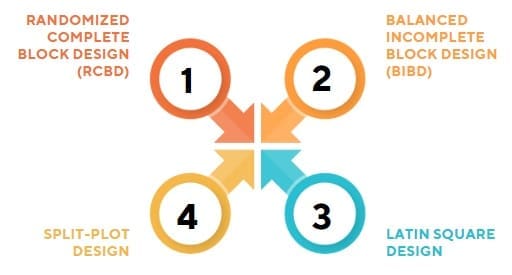Blocking is a powerful technique in statistics. It helps researchers control variability in experimental data. They use it to improve the accuracy and precision of their results. Blocking involves grouping experimental units. These units share similar characteristics. This creates homogenous groups or blocks. Researchers then assign treatments randomly within each block.
This ensures that each treatment is equally represented in each block. This reduces the influence of extraneous factors. These factors might affect the outcome of the experiment.
In statistics, blocking refers to the arrangement of experimental units into groups, known as blocks, based on certain characteristics. This technique aims to control for variability arising from nuisance variables, thereby increasing the precision of experimental results.
What is Blocking?
Blocking is a fundamental concept in experimental design. It helps researchers isolate the effect of the treatment. They want to eliminate the influence of other factors. These factors are called nuisance factors. They can obscure the true effect of the treatment. Blocking helps to control these nuisance factors. It ensures that they do not bias the results.
Historical Background
The concept of blocking was introduced by the esteemed statistician Ronald A. Fisher. His pioneering work in the early 20th century laid the foundation for modern experimental design, emphasizing the importance of controlling extraneous variability to obtain reliable results.
Purpose of Blocking
The primary objective of blocking is to account for variability that is not of direct interest but could influence the outcome. By grouping similar experimental units together, researchers can isolate the effect of the primary factor under study, leading to more accurate and interpretable results.
Why is Blocking Important?
Blocking is important because it improves the efficiency of an experiment. It reduces the impact of variability. This leads to more accurate and reliable results. Blocking also helps to increase the power of an experiment. This means it is more likely to detect a significant effect if one exists.
How Blocking Works?
Blocking works by grouping experimental units into blocks. These blocks are based on shared characteristics. These characteristics might influence the outcome of the experiment. By grouping similar units, researchers reduce the variability within each block. This makes it easier to detect the effect of the treatment.
Example of Blocking
Imagine an experiment testing the effectiveness of a new fertilizer. The researchers want to control for soil type. Soil type can affect plant growth. They divide the experimental field into blocks.
Each block has a different soil type. They then randomly assign different fertilizer treatments within each block. This ensures that each fertilizer is tested on each soil type. This eliminates the influence of soil type on the results.
Choosing Blocking Factors
Choosing appropriate blocking factors is crucial for effective blocking. Researchers should consider factors that might influence the outcome of the experiment. These factors should be measurable and controllable. They should also be relevant to the research question.
Types of Blocking Designs

There are various types of blocking designs. The choice of design depends on the specific needs of the experiment. Some common types include:
- Randomized Complete Block Design (RCBD): This is the most common type of blocking design. Each block receives all treatments. The treatments are randomly assigned within each block.
- Balanced Incomplete Block Design (BIBD): Researchers use this design when it is not possible to assign all treatments to each block. Each treatment appears the same number of times across all blocks.
- Latin Square Design: This design is used when there are two blocking factors. Each treatment appears once in each row and each column of the design.
- Split-Plot Design: Used when there are two levels of experimental units, such as whole plots and subplots. Researchers apply one factor to whole plots and another to subplots within each whole plot, allowing them to study hierarchical treatment structures.
Considerations in Blocking
Selection of Blocking Factors: It’s essential to choose blocking factors that are relevant and measurable. Over-blocking, or including too many factors, can lead to complexity without substantial gains in precision.
Balance and Replication: Ensuring that each treatment appears an equal number of times across blocks (balance) and that there are sufficient replications are vital for the statistical validity of the experiment.
Analysis of Block Effects: While blocking controls for nuisance variables, it’s important to analyze and interpret the effects of both blocking factors and treatments appropriately.
Advantages of Blocking in Statistics

Blocking offers several advantages in experimental design:
- Reduced variability: Blocking reduces the variability within each block. This makes it easier to detect the effect of the treatment.
- Increased precision: Blocking improves the precision of the estimates of treatment effects.
- Increased power: Blocking increases the power of the experiment to detect a significant effect.
- Control of nuisance factors: Blocking helps to control the influence of nuisance factors.
- Improved efficiency: Blocking can lead to more efficient use of resources.
Limitations of Blocking in Statistics

Blocking also has some limitations:
- Limited number of blocks: The number of blocks depends on the number of experimental units with similar characteristics.
- Increased complexity: Blocking can increase the complexity of the experimental design and analysis.
- Potential for bias: If researchers do not choose the blocking factors carefully, they can introduce bias into the results.
- Known Variability: Blocking is effective only for known and measurable sources of variability. This method cannot control unknown confounders.
- Resource Intensive: Some blocking designs may require more resources, such as additional experimental units or more complex randomization procedures.
Blocking in Different Research Areas
It is a versatile technique used in various research areas. Here are some examples:
Agriculture: Blocking is used to control for soil type, climate, and other environmental factors.
Medicine: Researchers use blocking to control for patient characteristics such as age, gender, and disease severity.
Engineering: Researchers use blocking to control for variations in materials, equipment, and manufacturing processes.
Social sciences: Researchers use blocking to control for demographic factors such as socioeconomic status and education level.
Blocking and Randomization
Blocking and randomization are two important concepts in experimental design. They work together to ensure the validity of the results. Randomization helps to control for unknown or unmeasured confounding variables. Blocking helps to control for known or measured nuisance factors.
Blocking in Statistical Software
Most statistical software packages offer tools for blocking. These tools help researchers to design and analyze blocked experiments. They can generate randomized block designs. They can also perform statistical analysis on the data.
Blocking and Experimental Validity
Blocking is crucial for ensuring the internal validity of an experiment. Internal validity refers to the extent to which the experiment accurately measures the effect of the independent variable. Blocking helps to eliminate alternative explanations for the results. This strengthens the causal inference.
Blocking and Generalizability
Blocking can also affect the external validity of an experiment. External validity refers to the extent to which the findings can be generalized to other populations or settings. Blocking can limit the generalizability of the findings if the blocks are not representative of the broader population.
Final Words
Blocking is a powerful technique in statistics. It helps researchers control variability and improve the accuracy of their results. By grouping experimental units with similar characteristics, researchers can isolate the effect of the treatment and eliminate the influence of nuisance factors.
Blocking is a versatile technique used in various research areas. It is an essential tool for ensuring the validity and reliability of experimental findings.


















